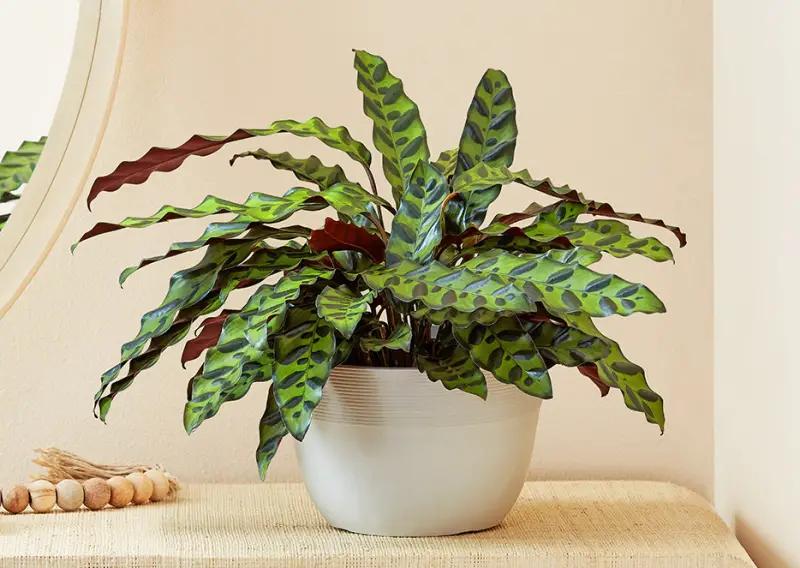The Rattlesnake plant (Goeppertia insignis), also known as the prayer plant or rattlesnake calathea, is a tropical evergreen houseplant that brings a unique, natural artistry. Native to the rainforests of Brazil, this plant is renowned for its beautifully patterned, green leaves with striking purple undersides. However, caring for a rattlesnake plant can be challenging.
This guide offers a comprehensive look into every aspect of rattlesnake plant care to help you cultivate a thriving, healthy plant indoors.
Overview of the Rattlesnake Plant

The rattlesnake plant originates from the tropical regions of South America, where it thrives under the filtered light of the rainforest canopy. Indoors, this plant grows to about 9-20 inches tall and spreads almost equally wide. Its foliage displays captivating green patterns.
- Common Names: Rattlesnake plant, prayer plant, rattlesnake calathea
- Botanical Name: Goeppertia insignis (formerly Calathea lancifolia)
- Family: Marantaceae
- Plant Type: Perennial
- Mature Size: 9–20 inches tall, 9–18 inches wide
- Sun Exposure: Partial or filtered light
- Soil Type: Moist but well-draining
- Soil pH: Acidic to neutral
- Bloom Time: Spring (blooms rarely indoors)
- Native Range: Tropical regions of South America
Essential Rattlesnake Plant Care Tips
Light Requirements for the Rattlesnake Plant
For the best growth, place your rattlesnake plant in an area with bright, indirect light. In its natural habitat, this plant receives filtered sunlight, so direct sunlight can scorch its leaves and diminish its colors. Position the plant near a north or east-facing window to provide it with gentle morning light. For west or south-facing windows, use a sheer curtain to diffuse the light. If natural light is limited, an LED grow light can offer the necessary brightness without causing leaf damage.
Choosing the Right Soil for the Rattlesnake Plant
The rattlesnake plant needs well-draining soil that retains moisture while avoiding waterlogging. A blend of two parts peat moss and one part perlite is ideal. The peat moss retains moisture, while perlite improves soil aeration. This soil mix also maintains a slightly acidic to neutral pH level (between 6-7), which is essential for nutrient absorption. Avoid alkaline soils as they can inhibit growth and vitality.
Watering the Rattlesnake Plant
Rattlesnake plants require a consistent watering schedule to keep the soil evenly moist, particularly during the warmer months. In spring and summer, water when the top inch of soil feels dry. In winter, reduce watering and allow the top layer of soil to dry before the next watering. Signs of overwatering include yellow leaves, while underwatering can cause the leaves to curl or brown. Aim to water just enough for excess to trickle out of the drainage holes, but avoid letting the plant sit in stagnant water.
Temperature and Humidity Requirements
To replicate the plant’s natural environment, maintain indoor temperatures between 60-75°F (16-24°C) and keep the plant away from drafts, heaters, or air conditioners. Humidity is crucial; low humidity can cause leaf edges to brown. To increase moisture, mist the leaves, place the plant on a pebble tray with water, or use a humidifier. High humidity levels will keep your plant’s foliage vibrant and healthy.
Fertilizing the Rattlesnake Plant
During the growing season (spring and summer), fertilize your rattlesnake plant monthly with a balanced liquid fertilizer diluted to half strength. Nutrients help boost foliage growth and accentuate the plant’s unique leaf patterns. In winter, when growth slows, refrain from fertilizing to prevent excess nutrient build-up, which can harm the roots.
Varieties of the Rattlesnake Plant and Similar Species
In addition to Goeppertia insignis, there are other Goeppertia plants with similar care needs.
- Goeppertia majestica is a larger variety with wide, gray-green leaves, growing up to three feet tall.
- Goeppertia makoyana (Peacock Plant) has feathery, peacock-like leaf patterns and reaches up to 40 inches.
- Goeppertia micans (Prayer Plant) is smaller, with leaves that fold at night.
- Goeppertia zebrina (Zebra Plant) features light green leaves with darker green stripes and grows about three feet tall.
These related species share similar care requirements and add beautiful diversity to any houseplant collection.
Maintenance Tips for the Rattlesnake Plant
Pruning the Rattlesnake Plant
Minimal pruning is needed for the rattlesnake plant. Remove dry or damaged leaves at the base of the stem using clean scissors. Regularly dusting the leaves with a damp cloth also prevents buildup and ensures the plant can efficiently absorb light.
Propagating the Rattlesnake Plant by Division
The easiest propagation method for the rattlesnake plant is by division. The ideal time is in spring when the plant enters its growth phase. Water the plant a day before, then gently remove it from the pot. Separate the root ball into sections, ensuring each has healthy roots and foliage. Pot the divisions in fresh soil, water thoroughly, and cover with a plastic bag to create a greenhouse effect until new growth appears.
Managing Pests in Rattlesnake Plant Care
Pests like aphids, spider mites, and mealybugs are common issues with rattlesnake plants. Regular inspection of leaf undersides can help detect infestations early. Treat affected areas with a mild solution of soapy water, neem oil, or insecticidal soap. Avoid harsh chemicals, as these may damage the sensitive leaves.
Troubleshooting Common Rattlesnake Plant Problems
Fading of Leaf Patterns
If leaf patterns begin to fade, the plant may be receiving improper lighting. Too much direct sunlight causes green spots, while insufficient light leads to dull colors. Adjusting the plant’s exposure to bright, indirect light should restore its vibrant appearance.
Limp or Rotting Stems
Limp or rotting stems often result from overwatering or exposure to drafts. Move the plant to a draft-free area and let the soil dry out before the next watering session. Providing a consistent temperature can also help revive the stems.
Brown Leaf Edges
Brown leaf edges indicate that the plant’s environment is too dry. Increasing humidity around the plant with misting or a humidifier should resolve this issue. Avoid using commercial leaf shine, as it can cause brown spots. Instead, wipe the leaves with a damp cloth to remove dust.
Encouraging Blooms in Rattlesnake Plants
Rattlesnake plants rarely bloom indoors, but under ideal conditions, they may produce small yellow flowers. Creating a warm, humid environment with consistent bright light can help encourage blooms. While these flowers are small and less showy than the foliage, they add a unique charm to this plant.
Final Thoughts on Rattlesnake Plant Care
The rattlesnake plant can be a rewarding addition to your indoor garden with proper care. By creating an environment similar to its natural habitat—offering bright, indirect light, balanced watering, and high humidity—you’ll enjoy its unique and vibrant foliage for years to come. This tropical beauty not only enhances your space aesthetically but also brings a touch of the rainforest into your home.






